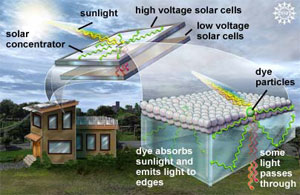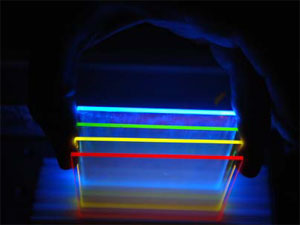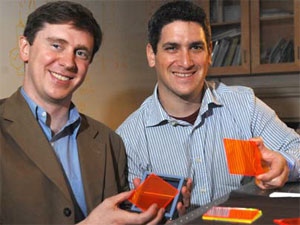CAMBRIGE, Mass., July 11, 2008 – As Photovoltaic (PV) technology continues to evolve there are two obvious focal points that continue to garner the most attention – cost and efficiency. Reports of a new approach to harnessing the sun’s energy not only deflates cost and improves efficiency, but also has a practical and aesthetic appeal.
Researchers at MIT have fashioned a new technology that can turn a window into a solar panel, simply by painting light-absorbing dyes onto a pane of glass. Rooftop solar panels, for example, are bulky and expensive and their days might be numbered thanks to this new technology, which involves what the MIT researchers are calling “solar concentrators.” 
The illustration shows how a cost effective solar concentrator could help make existing solar panels more efficient. The dye-based organic solar concentrator functions without the use of tracking or cooling systems, greatly reducing the overall cost compared to other concentrator technologies. Dye molecules coated on glass absorb sunlight, and re-emit it at a different wavelengths. The light is trapped and transported within the glass until it is captured by solar cells at the edge. Some light passes through the concentrator and can be absorbed by lower voltage solar cells underneath. Alternatively, the partially transmissive concentrator can function as a window. Photo courtesy of NSF.
“Light is collected over a large area (like a window) and gathered, or concentrated, at the edges,” explains Marc A. Baldo, leader of the work and the Esther and Harold E. Edgerton Career Development Associate Professor of Electrical Engineering.
As a result, the cells only need to be around the edges of a flat glass panel. And according to Baldo, the focused light increases the electrical power obtained from each solar cell by a factor of over 40.
Because the system is simple to manufacture, the team believes that it could be implemented within three years, and even added onto existing solar-panel systems to increase their efficiency by 50 percent for minimal additional cost. That, in turn, would substantially reduce the cost of solar electricity.
In addition to Baldo, the researchers involved are Michael Currie, Jon Mapel, and Timothy Heidel, all graduate students in the Department of Electrical Engineering and Computer Science, and Shalom Goffri, a postdoctoral associate in MIT's Research Laboratory of Electronics.
"Professor Baldo's project utilizes innovative design to achieve superior solar conversion without optical tracking," says Dr. Aravinda Kini, program manager in the Office of Basic Energy Sciences in the U.S. Department of Energy's Office of Science, a sponsor of the work. "This accomplishment demonstrates the critical importance of innovative basic research in bringing about revolutionary advances in solar energy utilization in a cost-effective manner."
According to Baldo and his colleagues, solar concentrators in use today "track the sun to generate high optical intensities, often by using large mobile mirrors that are expensive to deploy and maintain. Cells at the focal point of the mirrors must be cooled, and the entire assembly wastes space around the perimeter to avoid shadowing neighboring concentrators."

Organic solar concentrators collect and focus different colors of sunlight. Solar cells can be attached to the edges of the plates. By collecting light over their full surface and concentrating it at their edges, these devices reduce the required area of solar cells and consequently, the cost of solar power. Stacking multiple concentrators allows the optimization of solar cells at each wavelength, increasing the overall power output. Photo courtesy of Donna Coveny.
The MIT solar concentrator involves a mixture of two or more dyes that is essentially painted onto a pane of glass or plastic. The dyes work together to absorb light across a range of wavelengths, which is then re-emitted at a different wavelength and transported across the pane to waiting solar cells at the edges.
In the 1970s, similar solar concentrators were developed by impregnating dyes in plastic. But the idea was abandoned because, among other things, not enough of the collected light could reach the edges of the concentrator. Much of it was lost en route.
The MIT engineers, experts in optical techniques developed for lasers and organic light-emitting diodes, realized that perhaps those same advances could be applied to solar concentrators. The result? A mixture of dyes in specific ratios, applied only to the surface of the glass that allows some level of control over light absorption and emission.

Marc Baldo, associate professor of electrical engineering and computer science (left) and Shalom Goffri, postdoc in MIT's Research Laboratory of Electronics (right) hold examples of organic solar concentrators. Photo courtesy of Donna Coveny.
"We made it so the light can travel a much longer distance," Mapel says. "We were able to substantially reduce light transport losses, resulting in a tenfold increase in the amount of power converted by the solar cells."
This work was also supported by the National Science Foundation. Baldo is also affiliated with MIT's Research Laboratory of Electronics, Microsystems Technology Laboratories, and Institute for Soldier Nanotechnologies.
Mapel, Currie and Goffri are starting a company, Covalent Solar, to develop and commercialize the new technology. Earlier this year Covalent Solar won two prizes in the MIT $100K Entrepreneurship Competition. The company placed first in the Energy category ($20,000) and won the Audience Judging Award ($10,000), voted on by all who attended the awards.
For more information, visit: www.mit.edu